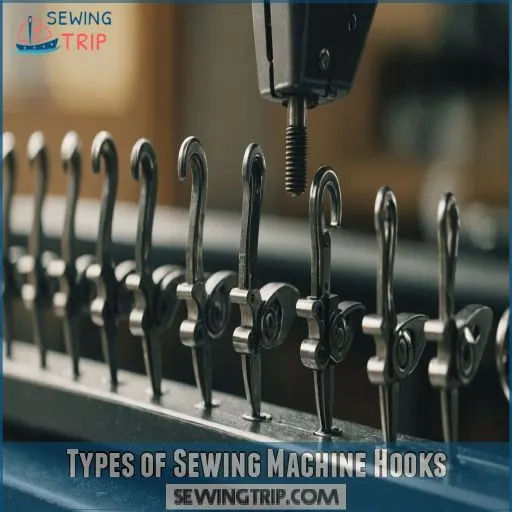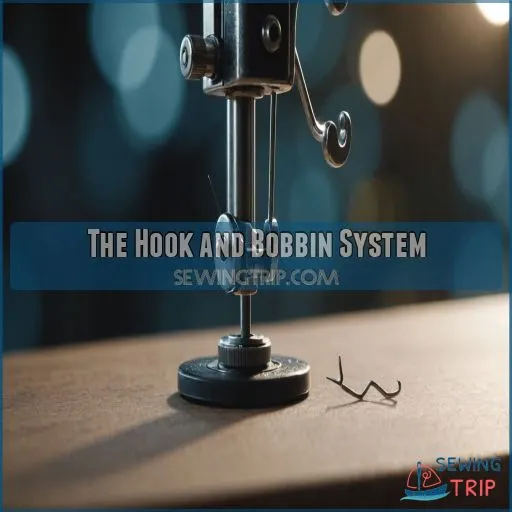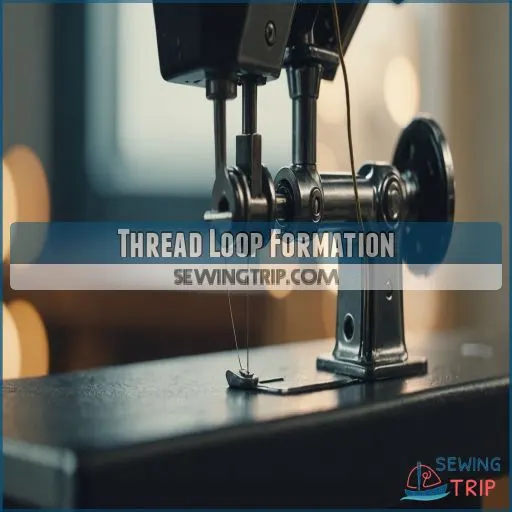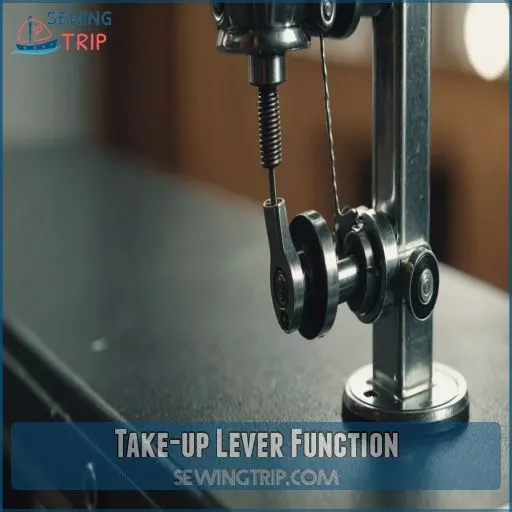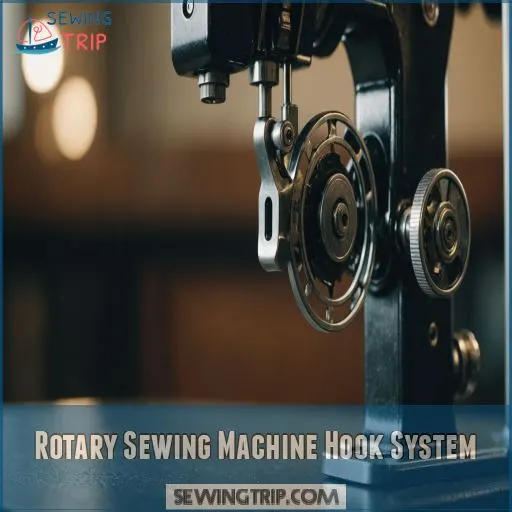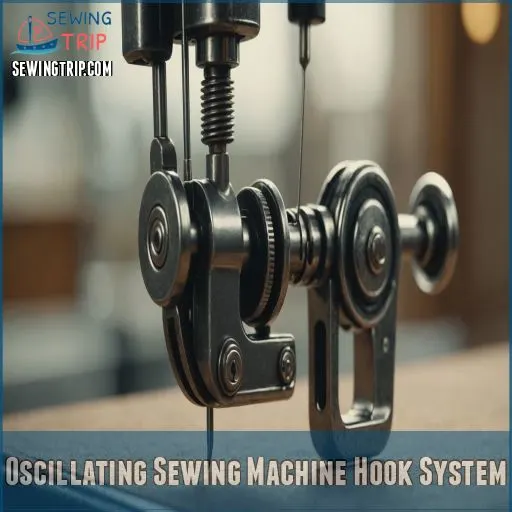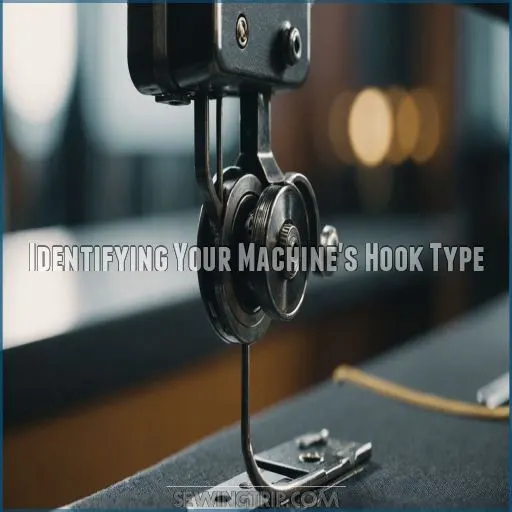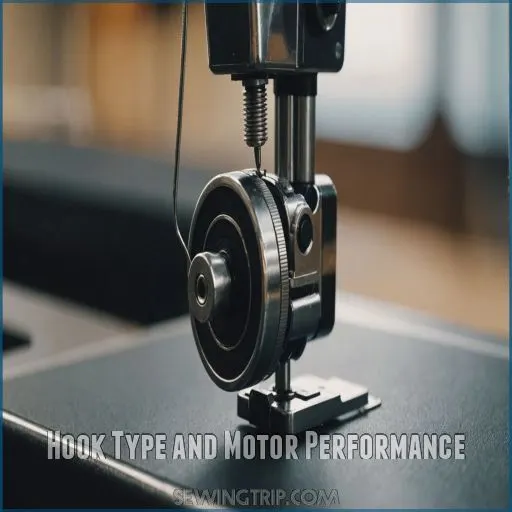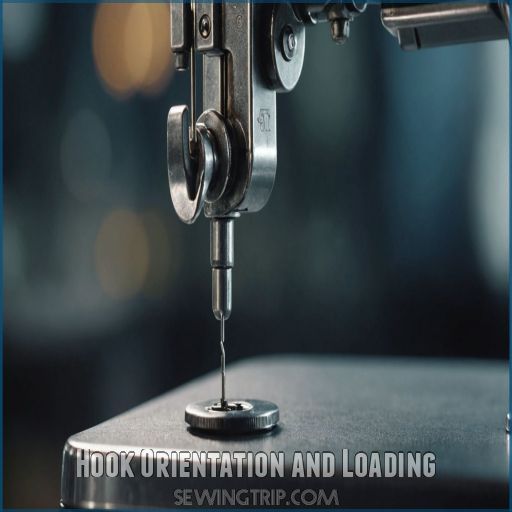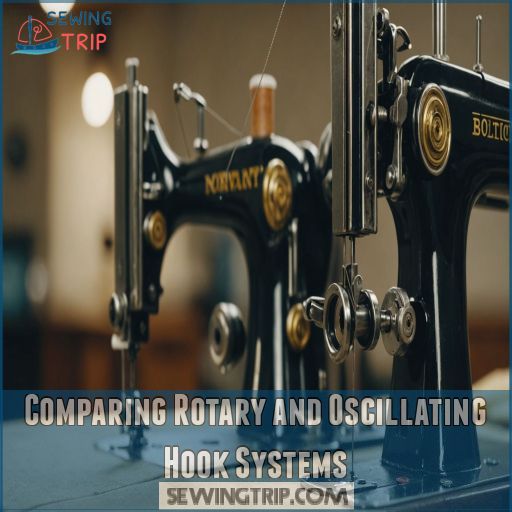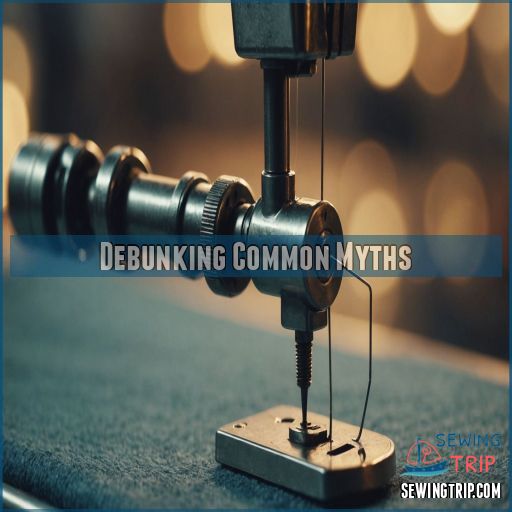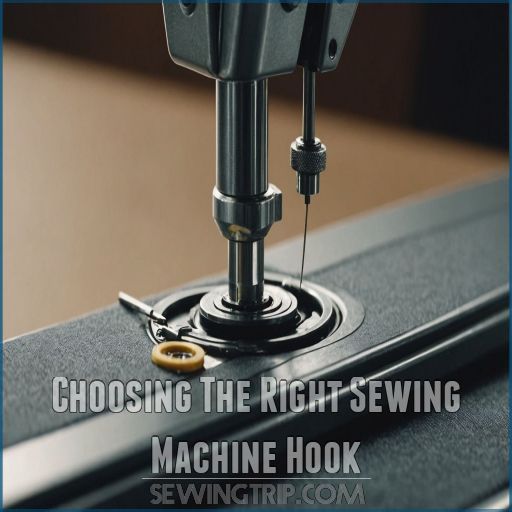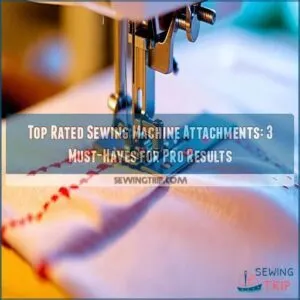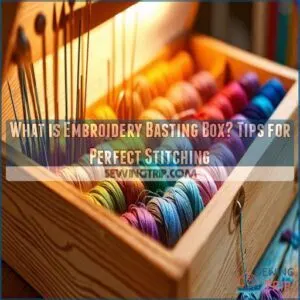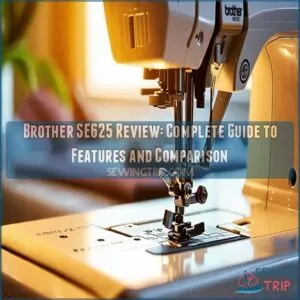This site is supported by our readers. We may earn a commission, at no cost to you, if you purchase through links.
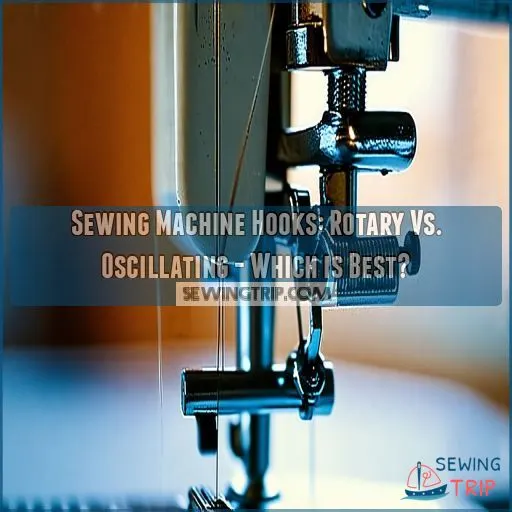 If you’re looking to sew with ease, understanding the different types of sewing machine hooks—oscillating and rotary—and their orientations can make a world of difference.
If you’re looking to sew with ease, understanding the different types of sewing machine hooks—oscillating and rotary—and their orientations can make a world of difference.
Rotary hooks operate in a circular motion, offering speed and precision, perfect for those high-speed projects.
They often come in horizontal or vertical configurations, affecting how you load the bobbin.
Meanwhile, oscillating hooks move back and forth, known for their simplicity and versatile thread handling, making them great for various fabrics.
Choosing between horizontal and vertical setups impacts bobbin access and stitch outcomes.
Ready to stitch with flair? Let’s unravel the details in mastering these hook types!
Table Of Contents
- Key Takeaways
- Types of Sewing Machine Hooks
- How Sewing Machine Hooks Work
- Rotary Sewing Machine Hook System
- Oscillating Sewing Machine Hook System
- Identifying Your Machine’s Hook Type
- Hook Type and Motor Performance
- Hook Orientation and Loading
- Comparing Rotary and Oscillating Hook Systems
- Debunking Common Myths
- Choosing The Right Sewing Machine Hook
- Frequently Asked Questions (FAQs)
- Conclusion
Key Takeaways
- You’ll benefit from understanding the difference between rotary and oscillating hooks; rotary hooks are ideal for high-speed, precise sewing, whereas oscillating hooks offer simplicity and versatility across various fabrics.
- Consider hook orientation—horizontal hooks make top-loading bobbins easier to access, while vertical hooks might suit spaces with unique constraints.
- Maintenance is simpler with oscillating hooks due to fewer parts and a forgiving nature, while rotary hooks, though requiring more upkeep, deliver smoother operation at high speeds.
- Your sewing projects’ needs should guide your choice between hook types; think about what matters most to you, whether it’s speed, ease of use, or handling diverse textiles.
Types of Sewing Machine Hooks
When you’re exploring sewing machines, you’ll encounter two primary types of hooks: rotary and oscillating.
Understanding these hooks is essential, as they determine how smoothly your machine operates and what kinds of threads you can use.
Rotary Hook Machines
Rotary hook machines offer smooth, uninterrupted motion, keeping thread tension consistent, and reducing jams.
They’re ideal for high-speed industrial sewing since their circular motion prevents vibration, allowing for faster, quieter operation.
Essential for vintage sewing machines and modern counterparts, regular lubrication with sewing machine oil is key to preventing wear and tear on delicate machine parts. Their maintenance involves regular cleaning and lubrication.
Comparing hook types reveals rotary hooks’ efficiency in handling speed and industrial applications.
Oscillating Hook Machines
While the rotary hook smoothly spins full circle, oscillating hook machines offer a back-and-forth motion, providing simpler mechanics and fewer parts.
This makes them easier for maintenance and ideal for various thread sizes.
Specifically used in brands like Sailrite, they suit top loading designs and lock stitch sewing, marrying versatility with user-friendly sewing machine specifications (Source).
Comparison of Rotary and Oscillating Hooks
Exploring oscillating setup, now let’s compare both hooks.
Rotary hooks excel in sewing speed and produce less noise, ideal for high-speed tasks.
Oscillating hooks are simpler, with fewer repair needs, and handle thread tension changes well.
Consider these points:
- Sewing speed
- Thread tension adaptability
- Noise level
- Maintenance cost
Your choice depends on sewing goals.
How Sewing Machine Hooks Work
The needle mechanism uses a special eye to push thread through fabric without piercing itself, as explained in How Sewing Machines Work. When you sew, the hook and bobbin system in your machine works to form stitches by catching the thread loop created behind the needle.
The take-up lever then tightens each stitch, ensuring smooth and secure results as the fabric moves under the needle.
The Hook and Bobbin System
The hook is responsible for grabbing and looping the thread from the bobbin, which can sometimes lead to bobbin threading issues, but when functioning properly, your sewing machine’s magic lies in its hook and bobbin system.
The hook, whether rotary or oscillating, interacts with the bobbin, creating the stitch.
Proper bobbin tension is key for perfect stitch formation.
Needle timing makes sure the upper and lower threads interlock correctly.
Regular hook maintenance, including cleaning, prevents jams.
Different bobbin types exist, affecting stitch quality.
Understanding this system gives you control over your sewing.
Thread Loop Formation
Thread loop formation is a dance of precision.
As the needle moves, the sewing machine hook snags the upper thread, swiftly creating a loop around the bobbin.
Proper shuttle hook function makes sure the thread is cut evenly and accurately, which is vital for maintaining consistent stitch formation.
Oscillating and rotary hooks differ in motion, yet both manage thread tolerances effectively, vital for smooth sewing operations.
Take-up Lever Function
In the intricate dance of sewing machine hooks, the take-up lever plays a pivotal role.
By controlling tension control and stitch formation, it helps maintain smooth thread flow.
Whether your system is oscillating rotary or fixed vertically, proper take-up lever adjustment prevents timing issues.
Troubleshooting problems often involves checking this lever, as it influences the overall stitch quality and reliability.
Rotary Sewing Machine Hook System
In a rotary sewing machine hook system, the hook rotates continuously in a circular motion around a stationary bobbin, minimizing vibration and ensuring smooth operation.
This design allows for rapid, high-speed sewing, making it ideal for industrial applications where efficiency and precision are essential.
Continuous Motion and Speed
Exploring how sewing machine hooks work brings us to the rotary system’s continuous motion and speed.
Enjoy seamless sewing with the rotary hook, where precision meets performance.
Here’s why it shines:
- Enhanced sewing speed.
- Consistent stitch quality.
- Higher motor power handling.
- Accurate RPM limits.
Keep stitching effortlessly, mastering control over your machine.
Reduced Vibration and Smooth Operation
Rotary sewing machine hooks offer benefits like reduced vibration and smooth operation, enhancing your sewing experience.
Their continuous motion, unlike oscillating hooks, minimizes resistance, resulting in less vibration and quieter operation.
This feature can be particularly beneficial in industrial machine designs, where minimizing noise and maintaining precision are highly important.
Additionally, the versatility of oscillating hooks in handling various thread types, including delicate silks and heavy-duty denim, is an important consideration when choosing the right hook system Oscillating hook sewing machines.
This feature can be particularly beneficial in industrial machine designs, where minimizing noise and maintaining precision are highly important (Source).
You’ll appreciate the calm and fluid sewing process it provides.
Ideal for High-Speed Sewing
Consider using a rotary hook system for high-speed sewing, achieving top speeds effortlessly. It excels in industrial sewing, handling thousands of stitches per minute with ease.
- Rotary hook advantages: Efficient and less vibration
- Sewing machine maintenance: Requires less frequent adjustments
- Industrial sewing: Ideal for heavy-duty tasks
- Top speed limits: Far beyond domestic machines
- Class 15 bobbin compatibility
Oscillating Sewing Machine Hook System
You’ll find oscillating hooks simpler to maintain than their rotary counterparts, boasting fewer parts and easier timing.
This system’s forgiving nature makes it a popular choice for those new to sewing, or anyone who appreciates a less finicky machine.
Simpler Mechanics and Fewer Parts
With oscillating sewing machine hooks, you’ll enjoy simpler mechanics and fewer parts, making them easier to maintain.
These hooks oscillate back and forth, reducing the complexity involved compared to rotary systems.
This results in improved durability and lower costs due to fewer repairs and upgrades required over time.
Plus, their straightforward design guarantees reliable performance across horizontal and vertical configurations.
More Forgiving and Easier Maintenance
Easier upkeep and fewer adjustments make oscillating hook sewing machines a solid choice, especially for beginners.
These systems handle sewing machine maintenance effortlessly by having simpler mechanics and forgiving timing variances.
Need some DIY maintenance tips? This’s where oscillating hook pros shine, helping you understand hook type impact without breaking a sweat or your machine.
Suitable for Various Thread Sizes
Leaving behind easier maintenance, let’s explore how oscillating hook systems cater to various thread sizes.
These systems handle different threads effectively due to their simpler mechanics.
Key factors include:
- Thread weight flexibility: Greater tolerance for heavier threads.
- Thread tension management: Adapts to different tensions effortlessly.
- Needle size compatibility: Supports a range of needle sizes, optimizing diverse sewing techniques.
Identifying Your Machine’s Hook Type
To identify your sewing machine’s hook type, start by checking the machine’s specifications and observing the hook motion.
If the hook changes direction, it’s oscillating.
If it completes a full circle, it’s rotary.
Checking Machine Specifications
Begin by examining your sewing machine’s manual for hook type details, focusing on horizontal or vertical orientations.
Knowing your bobbin size, needle type, and motor power helps too.
Specifications often reveal whether your machine uses oscillating or rotary hooks, which affects performance and maintenance needs.
Manuals are key, so don’t skip this step—knowledge is power in sewing!
Observing Hook Motion
To identify your sewing machine’s hook type, observe the hook motion.
Watch for the hook motion pattern: does it spin continuously or oscillate back and forth?
Listen for the hook motion sound; rotary hooks often produce quieter, smoother sounds.
Pay attention to the hook motion direction and speed, as these technical aspects can reveal your machine’s sewing capabilities.
Distinguishing Between Rotary and Oscillating Hooks
Now that you’ve observed the hook’s motion, let’s distinguish between rotary and oscillating hooks. A rotary hook spins in a complete circle, while an oscillating hook moves back and forth. This difference impacts stitch quality, sewing speed, and maintenance. Proper hook timing, such as that described in hook assembly repair, is key for achieving the best results. See the hook’s full rotation? That’s rotary! Notice a back-and-forth motion? It’s oscillating! Hook type affects your sewing speed. Different hooks need different maintenance.
Hook Type and Motor Performance
When choosing between rotary and oscillating hooks, understanding how motor type impacts performance is really important.
You’ll find that external and internal motor configurations, along with gear-driven versus belt-driven systems, affect efficiency and sewing speed in a big way.
External Vs Internal Motors
Choosing between external and internal motors affects your sewing machine’s performance in a big way.
External motors allow easy upgrades, enhancing motor efficiency and lifespan, but require careful belt tension management.
Internal motors benefit from sleek integration, offering a compact design and stable performance without the need for frequent adjustments.
Knowing your sewing machine hooks, including oscillating or rotary types, helps tailor motor choices to your needs.
Gear-Driven Vs Belt-Driven Motors
Understanding motor types helps you achieve the best sewing efficiency and noise management.
Gear-driven motors offer durability and power, often preferred by sewing machine engineers for heavy-duty tasks.
On the other hand, belt-driven motors usually yield quieter operation, possibly requiring less maintenance, which in turn affects overall cost.
Depending on your needs, each motor type supports various sewing machine hooks and timing systems.
Motor Amperage and Efficiency
Shifting gears from motor types, let’s focus on motor amperage and efficiency.
Choosing the right motor can enhance sewing speed and machine longevity.
Rotary hooks often benefit from efficient motors, leading to reduced power consumption and heat dissipation.
Understanding sewing machine truths helps avoid myths, optimizing your investment and ensuring your machine operates smoothly, whether it’s an oscillating or rotary system.
Hook Orientation and Loading
When choosing between horizontal and vertical hooks, consider how the bobbin loads, as it can affect your sewing projects.
Top loading bobbins are easier to access.
Side loading machines may limit twin needle capabilities.
Horizontal Vs Vertical Hooks
Vertical and horizontal sewing machine hooks each offer distinct benefits.
You enjoy improved sewing ease with horizontal hooks, as they allow top loading, granting easy bobbin access and accommodating twin needle setups.
Vertical hooks, however, might fit spaces with constraints, providing different bobbin orientations and supporting oscillating rotary functions.
Consider your sewing needs when selecting orientation.
Top Loading Vs Side Loading Bobbins
Now that you’ve grasped horizontal versus vertical hooks, let’s look at bobbin loading.
Top-loading bobbins, often "drop-in," offer ease of use and excellent bobbin visibility.
Side-loading, however, might provide better space efficiency in some machine designs.
Consider your priorities: quick access or compact storage?
Both methods work well; the best choice depends on your personal preference and sewing style.
Implications for Twin Needle Sewing
Understanding hook orientation is important for a twin needle setup.
Rotary hooks, whether horizontal or vertical, allow smoother bobbin loading and consistent fabric tension.
Additionally, for good embroidery results, utilizing automatic thread tension can greatly reduce thread breakage and improve overall performance.
Oscillating hooks can struggle with needle spacing and stitch width adjustments, potentially causing jams.
Choose a setup that balances ease of use with performance, ensuring your machine handles dual threads effortlessly.
Comparing Rotary and Oscillating Hook Systems
In comparing rotary and oscillating hook systems, you’ll find that each has unique benefits related to speed, smoothness, and versatility.
While rotary hooks offer quieter, high-speed performance with tighter thread tolerances, oscillating hooks provide easier maintenance and adapt better to varying thread types.
Speed and Smoothness
For sewing speed and smoothness, rotary hooks are generally the best choice.
They spin in full circles, reducing resistance and vibration, resulting in smoother stitches and quieter operation.
Oscillating hooks, although reliable, can introduce more vibration due to their back-and-forth motion.
Regular machine lubrication helps to achieve the best stitch quality and reduces wear over time.
Thread Tolerance and Versatility
You’ve got thread types to think about when weighing rotary against oscillating hook systems.
Oscillating hooks are designed to work with various bobbin sizes, such as using the correct size bobbin for different projects correct bobbin size. Oscillating hooks handle various sewing machine thread sizes with ease; their looser bobbin tension accommodates heavy fabrics without a hitch.
Rotary hooks, while precise, demand specific fabric weight and stitching needs.
Versatility shines with oscillating hooks for those who want to explore sewing machine versatility.
Maintenance and Complexity
With sewing machine geeks in mind, rotary hook systems demand detailed attention, including hook cleaning and lubrication tips to prevent motor issues and thread jamming.
Oscillating hooks, while easier to maintain, may still require gear replacement.
Consulting sewing machine experts helps keep your machine purring smoothly, allowing sewing machine nerds to relish in the technical dance of threads.
Debunking Common Myths
You might’ve heard that oscillating hooks produce weaker seams or that rotary hooks depend on bobbin orientation, but these claims aren’t entirely accurate.
When you understand the facts, such as the actual mechanics and limitations of these systems, you’ll be better equipped to choose the right hook for your sewing machine.
Oscillating Hooks and Seam Strength
Many believe oscillating hooks produce weaker seams, but that’s a myth!
Proper tension, thread type, stitch length, needle size, and fabric thickness impact seam strength far more than the hook type itself.
Consider these factors:
- Consistent thread tension is key.
- Appropriate needle size for your fabric is essential.
- Correct stitch length prevents skipped stitches.
Don’t let sewing machine folklore fool you; master these elements for superior results.
Rotary Hooks and Bobbin Orientation
Rotary hooks and bobbin orientation often lead to misconceptions.
Despite a common belief, rotary hooks aren’t limited to horizontal configurations or class 66 bobbins.
In reality, bobbin orientation doesn’t dictate the hook system used—it’s all about compatibility and performance.
Understanding how a sewing machine works, including its The Needle Mechanism, is crucial for optimal performance. Paying attention to thread tension and machine compatibility will make your sewing experience smooth and efficient.
Limitations of Rotary Hook Machines
You might hear myths about rotary hook machines, but let’s set things straight. While they face minor issues like thread jams and speed limits, these aren’t deal-breakers.
Consider:
- Thread size flexibility: Manage lighter threads with ease.
- Lower maintenance cost: Often less than complex oscillating systems.
- Versatility with heavy fabric: Handle varied textiles smoothly.
Choosing The Right Sewing Machine Hook
When choosing the right sewing machine hook, it’s crucial to think about your sewing needs and preferences, which influence your decision between rotary and oscillating systems.
You should evaluate machine performance, maintenance demands, and choose the hook type that best suits your projects to guarantee seamless sewing experiences.
Considering Sewing Needs and Preferences
Having debunked common myths, let’s examine your sewing needs.
Consider sewing machine speed, fabric types, and stitch quality.
For beginners, finding the right machine with features like interchangeable presser feet can greatly impact the choice of hook type.
Are you working on complex projects with varied threads? Then budget constraints might influence your choice between rotary and oscillating sewing machine hooks.
Enthusiasts, choose based on personal preference: speed for industrial, or simplicity for home use.
Evaluating Machine Performance and Maintenance
In evaluating machine performance, consider lubrication, cleaning, and timing.
Rotary hooks often need frequent timing adjustments but offer smoother operation at high speeds.
Oscillating hooks, on the other hand, require less maintenance and are more forgiving with thread tension, making troubleshooting simpler.
Whether horizontal or vertical, needle selection can impact performance, so choose wisely.
Selecting The Ideal Hook Type for Your Needs
Balancing machine performance with your sewing projects’ demands helps in picking the perfect hook type.
Consider your machine type, budget, and maintenance preferences.
Rotary hooks suit high-speed, smooth operations, but oscillating hooks handle varied thread sizes with ease.
Whether horizontal or vertical, choosing wisely aligns your sewing ambitions with current machine trends, ensuring efficient, enjoyable crafting.
Frequently Asked Questions (FAQs)
What is the difference between vertical and horizontal hooks on a sewing machine?
Vertical hooks load bobbins from the front, side, or rear.
Horizontal hooks load from the top.
Many prefer top-loading for easier access, though both options depend on your sewing style and specific machine model preferences.
What does horizontal rotary hook mean?
A horizontal rotary hook in a sewing machine works in tandem with a bobbin’s underside thread to create secure stitches, and rotates in a full circle around a stationary bobbin, situated on the machine’s bed.
This design enables smoother operation at high speeds, reducing vibration and enhancing stitch consistency.
What are the different types of sewing machine hooks?
Sewing machine hooks vary as rotary, oscillating, and CB types.
Rotary hooks spin a full circle, offering speed; oscillating hooks pivot partially, ideal for heavy-duty tasks.
CB hooks are a Bernina-specific oscillation variant.
What is the difference between rotary and oscillating sewing machines?
Nearly half of industrial sewing machines use rotary hooks for smoother operation.
Rotary hooks spin continuously, offering high speed with less vibration.
Oscillating hooks alternate direction, making them ideal for home use with simpler maintenance.
How do hook types affect stitch quality?
You control stitch quality by understanding how the hook interacts with the thread and needle.
A damaged or misaligned needle can lead to poor stitch quality.
A well-maintained hook helps create smooth stitching.
Can hook types impact fabric compatibility?
Imagine a time-traveling needle!
Different hook types influence fabric compatibility.
Rotary hooks excel with knits; others, like oscillating hooks, might struggle.
Always test your machine and needle combination on a scrap first.
What maintenance do sewing machine hooks need?
Regular maintenance for sewing machine hooks involves cleaning lint, oiling moving parts, and checking for correct timing.
Use a small brush for cleaning, apply appropriate oil, and make sure the hook aligns correctly with the needle for smooth operation.
Do hook systems change sewing speed options?
Picture yourself in a sewing studio, needle gliding effortlessly.
The hook system doesn’t directly affect sewing speed options, but advanced mechanisms like rotary hooks often improve consistency.
This can enhance overall sewing efficiency for various fabrics (Source).
Are specific hook types better for beginners?
For beginners, an ergonomic crochet hook offers comfort and control.
This helps reduce hand strain during extended sessions.
Don’t hesitate to experiment with various styles and materials to find the perfect fit for your needs.
Conclusion
Choosing between rotary and oscillating sewing machine hooks boils down to your specific needs.
Rotary hooks, with their speed and precision, suit those high-speed projects, while oscillating hooks offer simplicity and versatility for diverse fabrics.
Horizontal and vertical configurations influence bobbin access and stitch quality.
So, consider your sewing style and what you value most, whether it’s speed, textile variety, or ease of use.
Understanding these differences will help your sewing projects run smoothly and efficiently.

